Minwoo Lee
Synthetic Tabular Data Generation: A Comparative Survey for Modern Techniques
Jul 15, 2025Abstract:As privacy regulations become more stringent and access to real-world data becomes increasingly constrained, synthetic data generation has emerged as a vital solution, especially for tabular datasets, which are central to domains like finance, healthcare and the social sciences. This survey presents a comprehensive and focused review of recent advances in synthetic tabular data generation, emphasizing methods that preserve complex feature relationships, maintain statistical fidelity, and satisfy privacy requirements. A key contribution of this work is the introduction of a novel taxonomy based on practical generation objectives, including intended downstream applications, privacy guarantees, and data utility, directly informing methodological design and evaluation strategies. Therefore, this review prioritizes the actionable goals that drive synthetic data creation, including conditional generation and risk-sensitive modeling. Additionally, the survey proposes a benchmark framework to align technical innovation with real-world demands. By bridging theoretical foundations with practical deployment, this work serves as both a roadmap for future research and a guide for implementing synthetic tabular data in privacy-critical environments.
Fine-grained Gender Control in Machine Translation with Large Language Models
Jul 21, 2024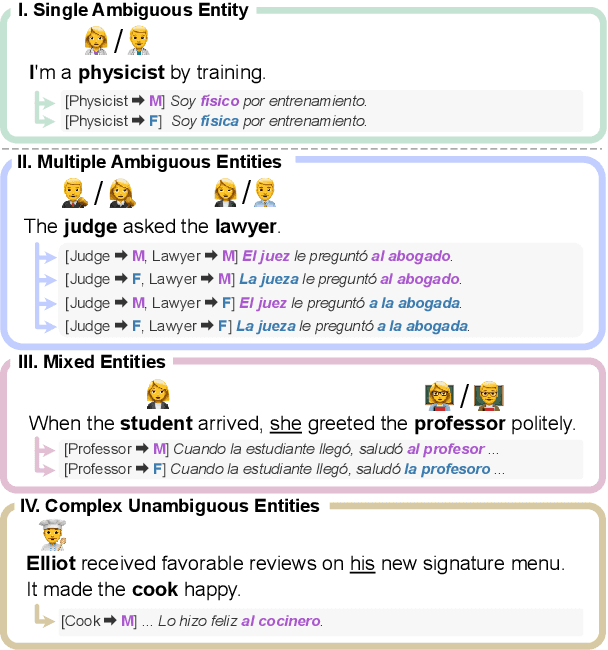
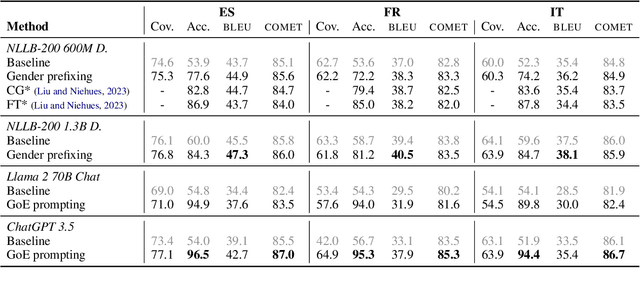
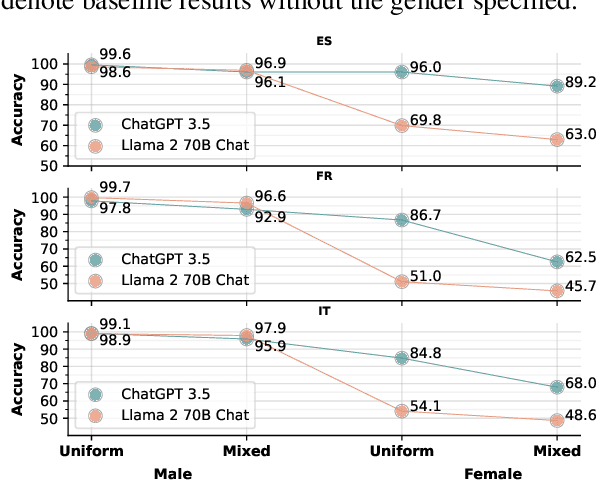
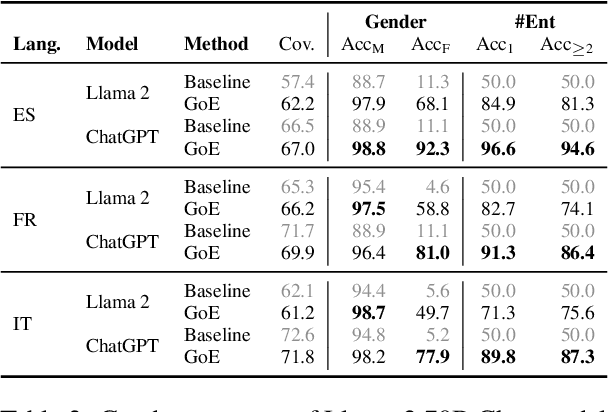
Abstract:In machine translation, the problem of ambiguously gendered input has been pointed out, where the gender of an entity is not available in the source sentence. To address this ambiguity issue, the task of controlled translation that takes the gender of the ambiguous entity as additional input have been proposed. However, most existing works have only considered a simplified setup of one target gender for input. In this paper, we tackle controlled translation in a more realistic setting of inputs with multiple entities and propose Gender-of-Entity (GoE) prompting method for LLMs. Our proposed method instructs the model with fine-grained entity-level gender information to translate with correct gender inflections. By utilizing four evaluation benchmarks, we investigate the controlled translation capability of LLMs in multiple dimensions and find that LLMs reach state-of-the-art performance in controlled translation. Furthermore, we discover an emergence of gender interference phenomenon when controlling the gender of multiple entities. Finally, we address the limitations of existing gender accuracy evaluation metrics and propose leveraging LLMs as an evaluator for gender inflection in machine translation.
Return of EM: Entity-driven Answer Set Expansion for QA Evaluation
Apr 24, 2024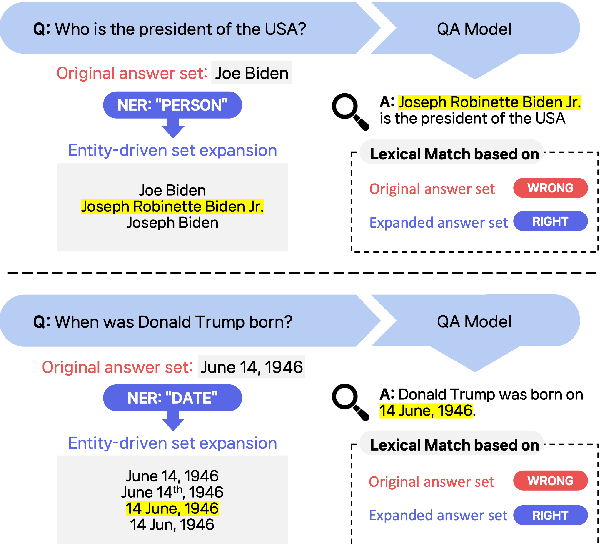
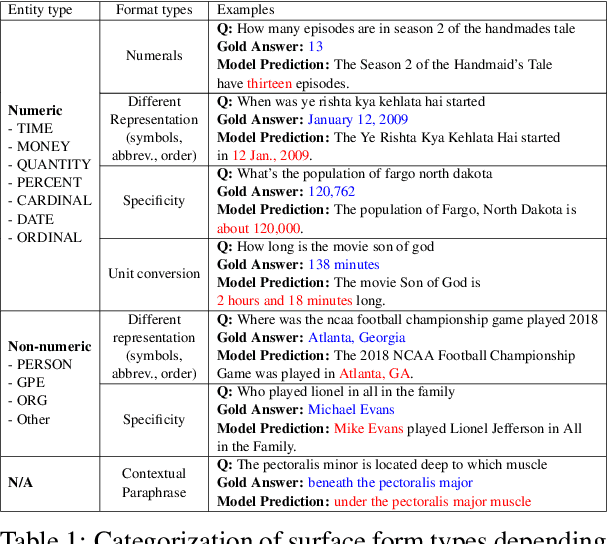
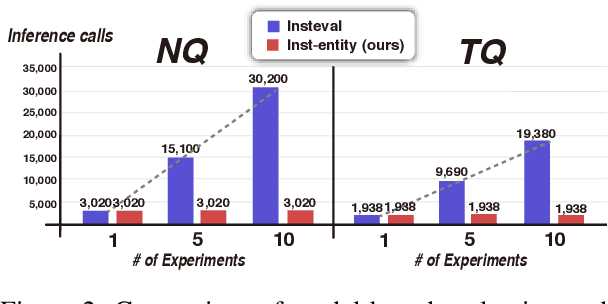
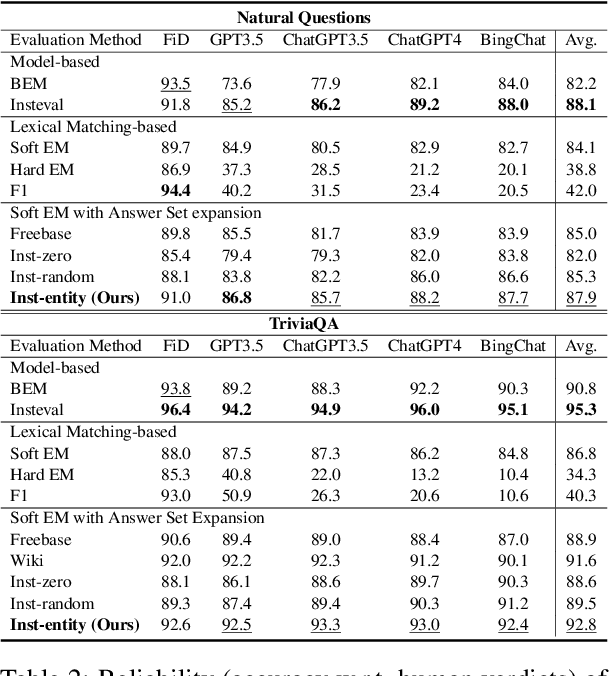
Abstract:Recently, directly using large language models (LLMs) has been shown to be the most reliable method to evaluate QA models. However, it suffers from limited interpretability, high cost, and environmental harm. To address these, we propose to use soft EM with entity-driven answer set expansion. Our approach expands the gold answer set to include diverse surface forms, based on the observation that the surface forms often follow particular patterns depending on the entity type. The experimental results show that our method outperforms traditional evaluation methods by a large margin. Moreover, the reliability of our evaluation method is comparable to that of LLM-based ones, while offering the benefits of high interpretability and reduced environmental harm.
BAMM: Bidirectional Autoregressive Motion Model
Apr 01, 2024



Abstract:Generating human motion from text has been dominated by denoising motion models either through diffusion or generative masking process. However, these models face great limitations in usability by requiring prior knowledge of the motion length. Conversely, autoregressive motion models address this limitation by adaptively predicting motion endpoints, at the cost of degraded generation quality and editing capabilities. To address these challenges, we propose Bidirectional Autoregressive Motion Model (BAMM), a novel text-to-motion generation framework. BAMM consists of two key components: (1) a motion tokenizer that transforms 3D human motion into discrete tokens in latent space, and (2) a masked self-attention transformer that autoregressively predicts randomly masked tokens via a hybrid attention masking strategy. By unifying generative masked modeling and autoregressive modeling, BAMM captures rich and bidirectional dependencies among motion tokens, while learning the probabilistic mapping from textual inputs to motion outputs with dynamically-adjusted motion sequence length. This feature enables BAMM to simultaneously achieving high-quality motion generation with enhanced usability and built-in motion editability. Extensive experiments on HumanML3D and KIT-ML datasets demonstrate that BAMM surpasses current state-of-the-art methods in both qualitative and quantitative measures. Our project page is available at https://exitudio.github.io/BAMM-page
Can LLMs Recognize Toxicity? Structured Toxicity Investigation Framework and Semantic-Based Metric
Feb 16, 2024Abstract:In the pursuit of developing Large Language Models (LLMs) that adhere to societal standards, it is imperative to discern the existence of toxicity in the generated text. The majority of existing toxicity metrics rely on encoder models trained on specific toxicity datasets. However, these encoders are susceptible to out-of-distribution (OOD) problems and depend on the definition of toxicity assumed in a dataset. In this paper, we introduce an automatic robust metric grounded on LLMs to distinguish whether model responses are toxic. We start by analyzing the toxicity factors, followed by examining the intrinsic toxic attributes of LLMs to ascertain their suitability as evaluators. Subsequently, we evaluate our metric, LLMs As ToxiciTy Evaluators (LATTE), on evaluation datasets.The empirical results indicate outstanding performance in measuring toxicity, improving upon state-of-the-art metrics by 12 points in F1 score without training procedure. We also show that upstream toxicity has an influence on downstream metrics.
Multi-Center Fetal Brain Tissue Annotation (FeTA) Challenge 2022 Results
Feb 08, 2024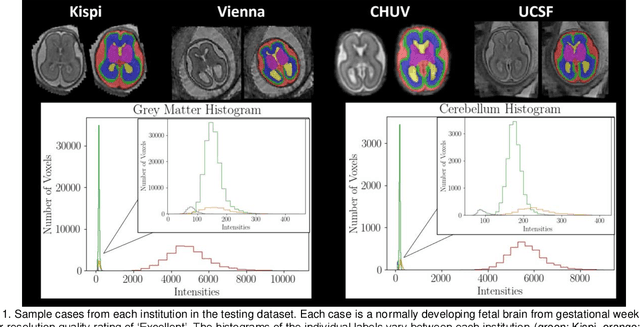
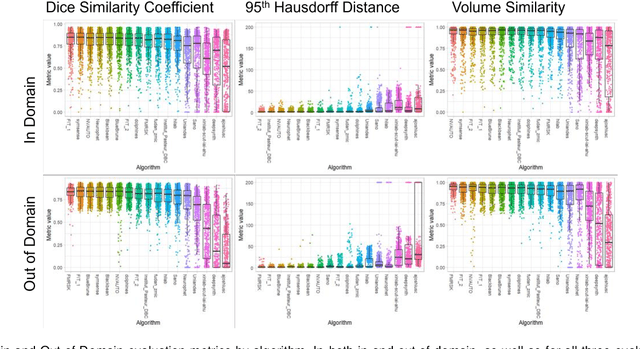
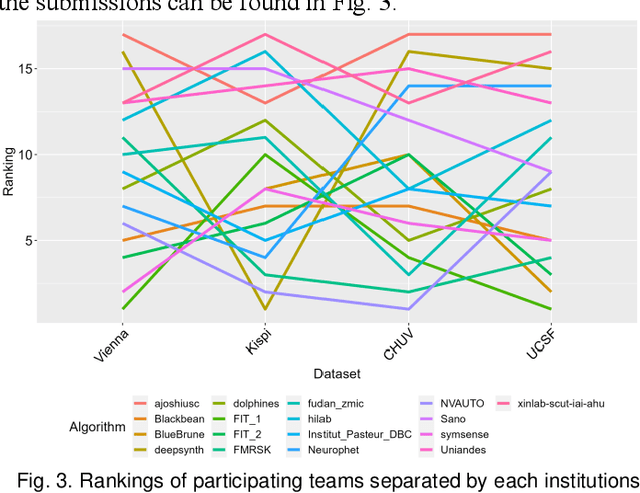
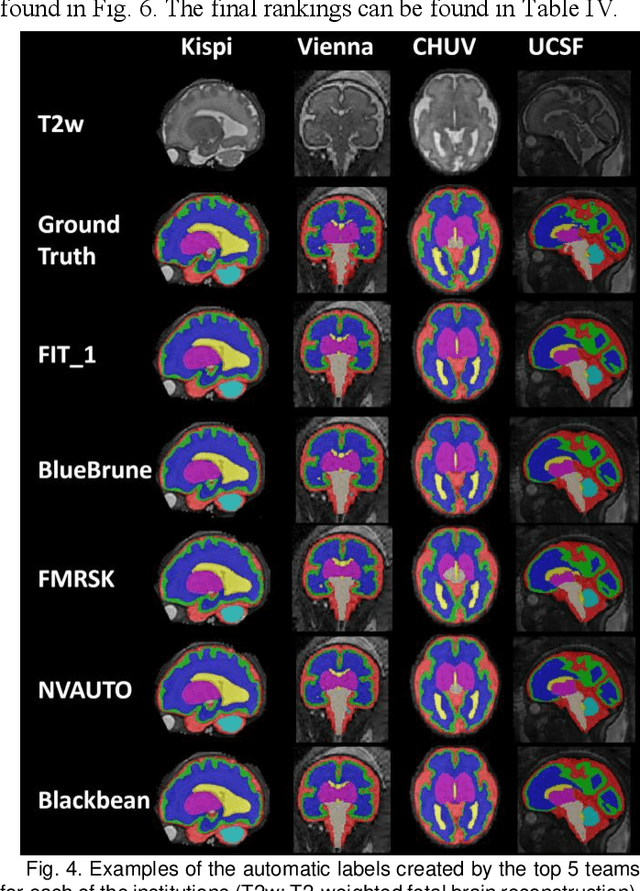
Abstract:Segmentation is a critical step in analyzing the developing human fetal brain. There have been vast improvements in automatic segmentation methods in the past several years, and the Fetal Brain Tissue Annotation (FeTA) Challenge 2021 helped to establish an excellent standard of fetal brain segmentation. However, FeTA 2021 was a single center study, and the generalizability of algorithms across different imaging centers remains unsolved, limiting real-world clinical applicability. The multi-center FeTA Challenge 2022 focuses on advancing the generalizability of fetal brain segmentation algorithms for magnetic resonance imaging (MRI). In FeTA 2022, the training dataset contained images and corresponding manually annotated multi-class labels from two imaging centers, and the testing data contained images from these two imaging centers as well as two additional unseen centers. The data from different centers varied in many aspects, including scanners used, imaging parameters, and fetal brain super-resolution algorithms applied. 16 teams participated in the challenge, and 17 algorithms were evaluated. Here, a detailed overview and analysis of the challenge results are provided, focusing on the generalizability of the submissions. Both in- and out of domain, the white matter and ventricles were segmented with the highest accuracy, while the most challenging structure remains the cerebral cortex due to anatomical complexity. The FeTA Challenge 2022 was able to successfully evaluate and advance generalizability of multi-class fetal brain tissue segmentation algorithms for MRI and it continues to benchmark new algorithms. The resulting new methods contribute to improving the analysis of brain development in utero.
MMM: Generative Masked Motion Model
Dec 06, 2023



Abstract:Recent advances in text-to-motion generation using diffusion and autoregressive models have shown promising results. However, these models often suffer from a trade-off between real-time performance, high fidelity, and motion editability. To address this gap, we introduce MMM, a novel yet simple motion generation paradigm based on Masked Motion Model. MMM consists of two key components: (1) a motion tokenizer that transforms 3D human motion into a sequence of discrete tokens in latent space, and (2) a conditional masked motion transformer that learns to predict randomly masked motion tokens, conditioned on the pre-computed text tokens. By attending to motion and text tokens in all directions, MMM explicitly captures inherent dependency among motion tokens and semantic mapping between motion and text tokens. During inference, this allows parallel and iterative decoding of multiple motion tokens that are highly consistent with fine-grained text descriptions, therefore simultaneously achieving high-fidelity and high-speed motion generation. In addition, MMM has innate motion editability. By simply placing mask tokens in the place that needs editing, MMM automatically fills the gaps while guaranteeing smooth transitions between editing and non-editing parts. Extensive experiments on the HumanML3D and KIT-ML datasets demonstrate that MMM surpasses current leading methods in generating high-quality motion (evidenced by superior FID scores of 0.08 and 0.429), while offering advanced editing features such as body-part modification, motion in-betweening, and the synthesis of long motion sequences. In addition, MMM is two orders of magnitude faster on a single mid-range GPU than editable motion diffusion models. Our project page is available at \url{https://exitudio.github.io/MMM-page}.
Asking Clarification Questions to Handle Ambiguity in Open-Domain QA
May 23, 2023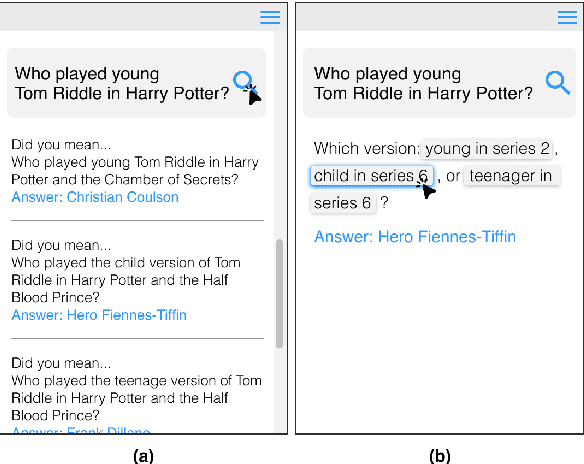

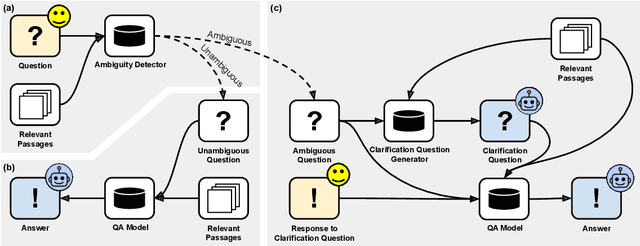

Abstract:Ambiguous questions persist in open-domain question answering, because formulating a precise question with a unique answer is often challenging. Previously, Min et al. (2020) have tackled this issue by generating disambiguated questions for all possible interpretations of the ambiguous question. This can be effective, but not ideal for providing an answer to the user. Instead, we propose to ask a clarification question, where the user's response will help identify the interpretation that best aligns with the user's intention. We first present CAMBIGNQ, a dataset consisting of 5,654 ambiguous questions, each with relevant passages, possible answers, and a clarification question. The clarification questions were efficiently created by generating them using InstructGPT and manually revising them as necessary. We then define a pipeline of tasks and design appropriate evaluation metrics. Lastly, we achieve 61.3 F1 on ambiguity detection and 40.5 F1 on clarification-based QA, providing strong baselines for future work.
Target-Agnostic Gender-Aware Contrastive Learning for Mitigating Bias in Multilingual Machine Translation
May 23, 2023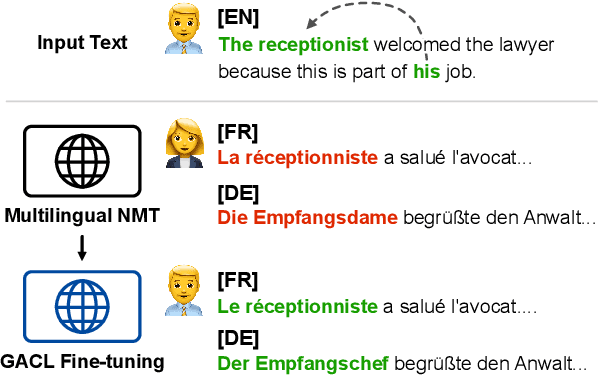



Abstract:Gender bias is a significant issue in machine translation, leading to ongoing research efforts in developing bias mitigation techniques. However, most works focus on debiasing of bilingual models without consideration for multilingual systems. In this paper, we specifically target the unambiguous gender bias issue of multilingual machine translation models and propose a new mitigation method based on a novel perspective on the problem. We hypothesize that the gender bias in unambiguous settings is due to the lack of gender information encoded into the non-explicit gender words and devise a scheme to encode correct gender information into their latent embeddings. Specifically, we employ Gender-Aware Contrastive Learning, GACL, based on gender pseudo-labels to encode gender information on the encoder embeddings. Our method is target-language-agnostic and applicable to already trained multilingual machine translation models through post-fine-tuning. Through multilingual evaluation, we show that our approach improves gender accuracy by a wide margin without hampering translation performance. We also observe that incorporated gender information transfers and benefits other target languages regarding gender accuracy. Finally, we demonstrate that our method is applicable and beneficial to models of various sizes.
GaitSADA: Self-Aligned Domain Adaptation for mmWave Gait Recognition
Feb 01, 2023



Abstract:mmWave radar-based gait recognition is a novel user identification method that captures human gait biometrics from mmWave radar return signals. This technology offers privacy protection and is resilient to weather and lighting conditions. However, its generalization performance is yet unknown and limits its practical deployment. To address this problem, in this paper, a non-synthetic dataset is collected and analyzed to reveal the presence of spatial and temporal domain shifts in mmWave gait biometric data, which significantly impacts identification accuracy. To address this issue, a novel self-aligned domain adaptation method called GaitSADA is proposed. GaitSADA improves system generalization performance by using a two-stage semi-supervised model training approach. The first stage uses semi-supervised contrastive learning and the second stage uses semi-supervised consistency training with centroid alignment. Extensive experiments show that GaitSADA outperforms representative domain adaptation methods by an average of 15.41% in low data regimes.
 Add to Chrome
Add to Chrome Add to Firefox
Add to Firefox Add to Edge
Add to Edge